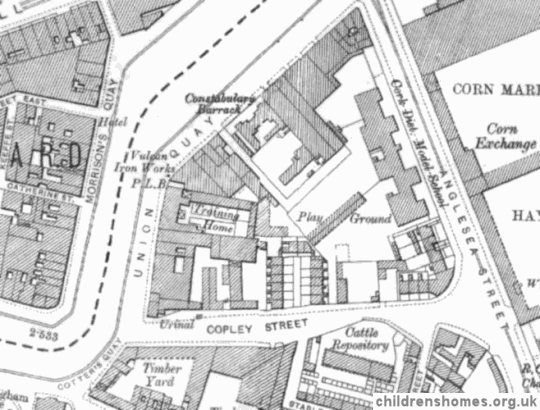Training Home Industrial School for Protestant Girls, Cork, Co. Cork, Republic of Ireland
The Glanmire and Passage West Industrial School for Protestant Girls, as it was originally known, was founded by the Rev. John Woodroffe, Rector of Glanmire. The School was given a temporary certificate to begin operation on 25 October 1870 in premises at Passage West, Co. Cork, which were lent by D'Esture Parker. It was managed by the Rector's daughter, Miss Elizabeth M. Woodroffe, superintended the institution. She and several of her colleagues belonged to the Protestant Sisterhood of Charity.
On 14 March 1871, a permanent site at 13 Union Quay, Cork, was certified for use and the 35 inmates at Passage West were transferred to the new premises, which became known as the Training Home Industrial School. In the autumn of the same year, an adjoining property was taken over. After some building work had been carried out, The School's facilities included a well-lit school room, sixty feet in length, two large classrooms, a 30-bed dormitory, a laundry and a large exercise yard. The School site is shown below.

Training Home Industrial School site, Cork, early 1900s.
An 1871 inspection report noted that the average number of girls under detention was 56. The girls learned needlework in all its branches. Machine work was also taught, and the girls made their own dresses. They also cooked, performed the household work of the establishment, and washed and made up fine linen in the laundry. In the classroom, the girls were instructed in reading, writing, spelling, dictation, grammar, arithmetic, geography, history and singing. Each older girl had two of her very young companions under her charge. It was her duty to see that they are neatly dressed, washed, and combed, and they thus learned the duties of household servants. There were twelve resident staff. Some ladies who resided in the institution paid £26 a year each towards their maintenance, besides giving their whole time gratuitously to its management; other members of the staff received some remuneration.
The capacity of the School was increased further additions to the buildings, including a new dormitory. The average number under detention in 1875 was 95.
In 1877, Miss Thorpe was noted as being the Lady Superintendent of the School. The girls' occupations now included assisting in the dairy and in the garden, milking cows and making butter. The following year, a large shed was erected in which the girls could play and exercise in wet weather. The income from laundry was increasingly valuable to the School's finances. It also allowed girls whose terms of detention had expired to stay on in the School and work in the laundry until they were able to obtain suitable employment outside.
A new building was erected in 1881. It ground floor, measuring 120 feet by 20 feet, was devoted to laundry purposes. The upper floor comprised two dormitories with a teacher's room between them. Glass partitions allowed the teacher to closely supervise the dormitories. At the same time, the dining hall was enlarged. As well as making all their own clothes, girls upholstered mattresses and knitted shawls, petticoats and stockings for their own use and for other schools. They produced an increasing number of items for outside customers, including dresses and mantles.
In 1890, it was reported that Miss Woodroffe had attempted to revive the culture of silkworms in the South of Ireland, and that the School had been equipped for the manufacture of silk.
On 12 November 1901, the School gave notice of the resignation of its certificate. On 31 March 1902, the inmates were transferred to the Meath Protestant Female Industrial School at Bray, Co. Wicklow.
The School buildings no longer exist and the Cork School of Music now occupies the site.
Records
Note: many repositories impose a closure period of up to 100 years for records identifying individuals. Before travelling a long distance, always check that the records you want to consult will be available.
- Barnardo's Origins Tracing Service — for people (and their families) who spent all or part of their childhood in an Irish Industrial School and are interested in tracing information about their parents, siblings or other relatives.
- Irish Petty Sessions Court Registers 1828-1912 (available online to subscribers of FindMyPast) include details of committals to Irish Reformatories and Industrial Schools.
Bibliography
- Arnold, Mavis, and Laskey, Heather Children of the Poor Clares (2004, Appletree Press)
- Barnes, Jane Irish Industrial Schools 1868-1908 (1989, Irish Academic Press)
- Dunne, Joe The Stolen Child: A Memoir (2003, Marion Books)
- Rafferty, Mary and O'Sullivan, Eoin Suffer the Little Children: The Inside Story of Ireland's Industrial Schools (1999, New Island Books)
- Touher, Patrick Fear of the Collar: Artane Industrial School — My Extraordinary Childhood (1991, O'Brien Press)
- Tyrrell, Peter and Whelan, Diarmuid Founded on Fear: Letterfrack Industrial School (2006, Irish Academic Press)
- Wall, Tom The Boy from Glin Industrial School (2015, Tom Wall)
- Higginbotham, Peter Children's Homes: A History of Institutional Care for Britain's Young (2017, Pen & Sword)
- Mahood, Linda Policing Gender, Class and Family: Britain, 1850-1940 (1995, Univeristy of Alberta Press)
- Prahms, Wendy Newcastle Ragged and Industrial School (2006, The History Press)
Links
- Glencree Reconciliation Centre (former Reformatory site)
- The Commission to Inquire into Child Abuse
Except where indicated, this page () © Peter Higginbotham. Contents may not be reproduced without permission.


